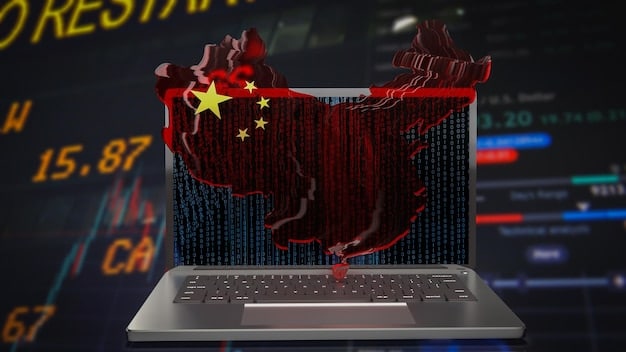The Future of US Foreign Policy: Trade & China Agreement Analysis

The Future of US Foreign Policy: Analyzing the Implications of the Recent Trade Agreement with China involves assessing the deal’s effects on economic, strategic, and diplomatic relations, impacting global trade, security alliances, and international norms, prompting shifts in US foreign policy strategies.
The interplay between economic agreements and geopolitical strategy has always been a cornerstone of international relations. In this context, understanding the future of US foreign policy: Analyzing the Implications of the Recent Trade Agreement with China is pivotal for stakeholders globally.
Understanding the US-China Trade Agreement
To fully grasp the implications of the recent trade agreement, a clear understanding of its provisions and objectives is essential. This section breaks down the key components of the agreement and sheds light on the aims of both the US and China in forging this accord.
The US-China trade agreement, often referred to as Phase One, involves various commitments from both sides. These range from intellectual property protection to agricultural purchases. A key aspect is China’s pledge to increase its purchases of US goods and services significantly.
Key Provisions of the Agreement
The agreement covers a wide array of issues, each designed to address specific concerns raised by the US. These provisions attempt to create a more balanced and fair trading relationship between the two nations.
- Intellectual Property: Enhanced protection against theft and counterfeiting, addressing a long-standing concern for US companies.
- Agricultural Purchases: China committed to purchasing billions of dollars worth of US agricultural products, providing substantial benefits to American farmers.
- Market Access: Measures aimed at opening up China’s markets to US companies in various sectors, increasing competition.

The agreement aims to resolve trade imbalances and promote a more equitable economic relationship between the US and China. While hailed as a step forward, its effectiveness and long-term impact remain a subject of debate among economists and policymakers alike.
Economic Implications for the US
The economic impacts of the trade agreement on the US are far-reaching, affecting various sectors and industries. Here, we analyze both the potential benefits and drawbacks for the US economy.
The agreement seeks to address the trade deficit and boost key sectors such as agriculture and manufacturing. However, concerns remain about the enforcement mechanisms and the overall impact on US competitiveness in the global market.
Potential Benefits
The agreement could bring several advantages, fostering economic growth and providing new opportunities for American businesses.
- Increased Exports: Higher demand for US goods in China may translate to increased exports and revenue for American companies.
- Job Creation: Expanded economic activity could lead to new job opportunities in exporting industries and related sectors.
- Investment: Greater market access may attract additional investment from both domestic and foreign sources.
Despite potential gains, the agreement also presents challenges, including the risk of increased competition and the need for continuous adaptation to evolving market conditions. As the agreement unfolds, its true impact on the US economy will become clearer.
In summary, the economic implications for the US are multifaceted, with both promises and potential pitfalls. Careful monitoring and strategic adjustments will be crucial to maximizing the benefits and mitigating the risks associated with the trade agreement.
Strategic Implications for US Foreign Policy
Apart from the immediate economic impacts, the trade agreement carries significant strategic implications for US foreign policy. The deal influences America’s relationships with allies, its approach to global trade, and its broader geopolitical strategy.
The trade agreement necessitates a recalibration of US foreign policy, particularly concerning its approach to China and its engagement in multilateral trade frameworks. The strategic implications are deeply intertwined with ongoing geopolitical dynamics.

The trade agreement is not simply an economic arrangement; it is a geopolitical maneuver with lasting consequences for the US’s role in global affairs.
Impact on US Relations with Allies
The US trade agreement with China has significant implications for its relationships with allies. Allies may perceive the agreement as deviating from established trade norms.
The agreement could strain relationships with key allies, particularly those pursuing similar trade agendas or concerned about the agreement’s fairness and transparency.
- European Union: The EU may view the agreement as a shift away from multilateralism and a turn toward bilateral deals.
- Asian Partners: Countries like Japan and South Korea could feel sidelined if the agreement redirects trade away from them.
Navigating these relationships will require the US to balance its strategic goals with the need to maintain strong alliances and foster multilateral cooperation.
Geopolitical Ramifications
The trade agreement influences broader geopolitical dynamics, including the balance of power and the role of international institutions.
The implications extend beyond bilateral relations, influencing the global balance of power and the effectiveness of international agreements. These ramifications require strategic foresight.
Influence on Global Trade
The agreement could reshape global trade patterns, potentially favoring the US and China at the expense of other nations.
In conclusion, the strategic implications on US foreign policy are intricate, requiring a comprehensive understanding of geopolitics, trade, and diplomatic relations. The US position in the global arena is subject to constant change.
Implications for Global Trade
Beyond the bilateral outcomes, the US-China trade agreement influences global trade dynamics, standards, and future trade negotiations.
The agreement sets a precedent for how major economies address trade imbalances and intellectual property issues, yet it may not represent a sustainable model for global trade governance.
New Global Trade Standards?
The agreement could influence how other countries negotiate trade deals in the future, potentially shifting the focus from multilateral to bilateral agreements.
The global trading system is evolving. It remains to be seen whether the agreement will spur a broader shift toward bilateralism or prompt renewed efforts to strengthen multilateral institutions.
Long-Term Effects on Innovation and Technology
The impact of the trade agreement on technological innovation is a critical concern. The agreement intends to protect intellectual property, which is vital for innovation.
How the agreement affects innovation is a topic of great speculation. The answers will depend on enforcement and the degree to which companies feel secure in investing in new technologies.
- Impact on Innovation: The agreement should boost innovation if it effectively reduces theft and protects intellectual property.
- Technology Transfer: Policies on technology transfer will influence innovation and how quickly technologies spread.
- Competition: Promoting fair competition will be essential for fostering continuous innovation.
The long-term effects on innovation are multifaceted, intertwined with intellectual property protection, technology transfer policies, and market competition. Constant adaptation and collaboration are key.
Conclusion
The US-China trade agreement presents a complex landscape of economic gains, strategic realignments, as well as implications for innovation and trade. The future of US foreign policy: Analyzing the Implications of the Recent Trade Agreement with China thus necessitate careful navigation, adaptive policymaking, and a sustained pursuit of balanced global relations. This approach will enable the US to harness opportunities, mitigate risks, and ensure its continued prominence in an ever-evolving global order.
| Key Point | Brief Description |
|---|---|
| 🤝 Trade Agreement | US-China Phase One deal, covering IP, agriculture, and market access. |
| 📈 Economic Impact | Potential gains via exports, jobs, and investment amid market challenges. |
| 🌍 Strategic Shifts | Recalibration of US foreign policy and global power balances. |
| 💡 Innovation | Intellectual property protection is expected to encourage innovation. |
FAQ
▼
The main points include increased Chinese purchases of US goods, enhanced intellectual property protection, and greater market access for US companies in various sectors. The goal is to reduce trade imbalances and encourage fairer trade practices.
▼
The agreement can strain US relations with its allies, particularly if these allies feel sidelined or perceive the deal as favoring the US and China at their expense. It may require the US to balance its strategic aims with alliance maintenance.
▼
The agreement influences global power dynamics by potentially reshaping trade routes and affecting the roles of international trade organizations. It signifies a shift towards bilateralism, which could alter established global trade practices and norms.
▼
If effectively enforced, the trade agreement’s intellectual property protections should stimulate innovation by reducing intellectual property theft. Clear technology transfer policies and promotion of market competition are also vital for fostering innovative practices.
▼
The US should adopt adaptive policymaking to navigate this agreement’s complex landscape. Maintaining solid global relations, monitoring the effects across sectors, and ensuring that the benefits outweigh risks are all critical steps.
Conclusion
In conclusion, the US-China trade agreement represents a pivotal moment in international trade relations. By understanding its implications, policymakers, businesses, and citizens can better navigate the evolving global landscape. Further analysis and adaptive strategies will be essential to harness the opportunities and mitigate the challenges ahead.





